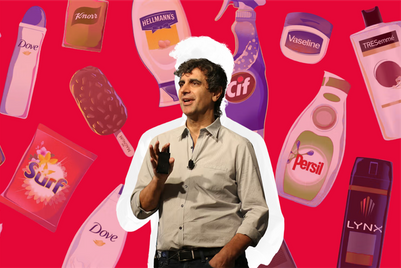
Until the start of December, fitness creator and business magnate Brian Johnson, AKA Liver King, has claimed a natural physique to his millions of social media followers. He appeared on the world’s biggest podcasts, including the H3 Podcast, Logan Paul’s Impaulsive and No Jumper, to affirm that he had never touched synthetic hormones and that his herculean body was the result of nothing more than a diet consisting of raw organs and intense exercise.
During that time, the 45-year-old peddled his nine ancestral tenants – a caveman ethos composed of common-sense knowledge such as ‘it’s healthy to sleep well and get sunshine,’ and unconventional wisdom like ‘eat animal balls instead of broccoli’ – to build an allegedly $100 million supplement and nutrition brand empire.
Earlier this month, however, Johnson was exposed for taking steroids and deceiving men about the lifestyle he promotes.
This kind of deception isn’t uncommon in the fitness creator space, leaving brands unsure which creators to trust.
“The thing that will give you pause right now if you’re a brand looking to work with influencers will be the contamination [Johnson] might have on the entire industry,” said Ryan Kutscher, founder of Circus Maximus. “There’s a point at which you’re like, ‘who am I supposed to believe?’”
Fitness creators command gargantuan followings for brands to potentially reach. The top five most popular creators have over 77 million followers across TikTok, YouTube and Instagram, according to British electronics retailer Currys PC World.
Vetting fitness creators is uniquely challenging, however, due to the sheer quantity of content they create and the toll of harsh dieting and exercise. Given that, some brands may not be ready to invest the time and effort needed to ensure a safe partnership in the space.
“Short-term thinking and lack of education has led marketers to treat influencers as a quick fix because they are incredibly effective at connecting brands to the cultural zeitgeist, driving relevance with their customers and delivering a bump in sales,” said Charlie Hart, EVP, North American integrated media lead at Current Global.
Fitness isn’t the only category with deception issues. Brands encounter similar issues with beauty creators as well. When targeting women, “we also see female celebrities who have undergone significant cosmetic enhancement promoting an anti-aging skincare line,” Hart said.
But deception is so common in the fitness space that the YouTuber who exposed Johnson has garnered over 1.6 million subscribers by posting videos that identify creators and celebrities who appear to take steroids and often claim otherwise.
“When it’s such a big creator like the Liver King and you’re making millions of dollars off of people, claiming your products are the reason you’re in this shape . . . that’s when the issue comes in,” said Abhish Desai, a fitness creator with more than 500,000 Instagram followers.
Fitness creators are expecting brands to grow distant and mistrusting as a result.
“The number one way [Johnson] will affect future creators and [current creators like] myself will be that brands will be more hesitant in working with you,” said Desai.
How to avoid a brand safety crisis
In order to avoid misaligned partnerships, brands need to vet fitness creators thoroughly, with both their reputations and the well-being of consumers in mind.
When a brand partners with a creator who dismisses the health benefits of eating vegetables, for example, it aligns with messaging that poses health risks.
“To mislead audiences to that extent and to have people potentially change their behaviors, what they consume and how they treat their bodies has a tremendous impact,” said Ryan O'Grady, VP of Finn Partners’ global health practice.
Monitoring for language that doesn’t align with a brand’s mission, huge bumps in follower counts that could indicate a large bot presence and comments that provide insight into the follower-creator relationship are all effective ways to vet creator partnerships across industries, O’Grady said.
When it comes to vetting fitness creators specifically, brands must look at their previous endorsements to ensure they are aligned with clients’ needs. Finn Partners, for instance, might pass on a creator who’s partnered with a weight loss company if it’s working for a holistic health client, O’Grady said.
Brands should also pay attention to fitness creators’ videos. Creators that share their knowledge and experience without promoting their exact lifestyle or unrealistic body goals are better suited for brand partnerships, Desai said.
At the end of the day, any brand-creator partnership comes down to trust. Fitness creators who want successful brand partnerships need to be honest and brands need to place these partnerships under intense scrutiny to ensure success for both parties.
“The degradation of trust among influencer audiences could lead to the cannibalization of the industry,” Hart said.


.jpg&h=334&w=500&q=100&v=20250320&c=1)
.jpg&h=334&w=500&q=100&v=20250320&c=1)
.jpg&h=334&w=500&q=100&v=20250320&c=1)




.png&h=334&w=500&q=100&v=20250320&c=1)

.png&h=334&w=500&q=100&v=20250320&c=1)
.png&h=268&w=401&q=100&v=20250320&c=1)
.jpg&h=268&w=401&q=100&v=20250320&c=1)




.png&h=268&w=401&q=100&v=20250320&c=1)
